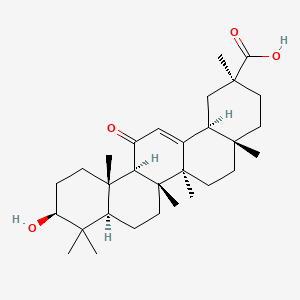| Authors | Title | Published | Journal | PubMed Link |
|---|---|---|---|---|
| Yu J et al. | Disruption of gap junctions reduces biomarkers of decidualization and angiogenesis and increases inflammatory mediators in human endometrial stromal cell cultures. | 2011 | Mol. Cell. Endocrinol. | pmid:21767601 |
| Reuss B et al. | Regionally distinct regulation of astroglial neurotransmitter receptors by fibroblast growth factor-2. | 2000 | Mol. Cell. Neurosci. | pmid:10882482 |
| Huang YC et al. | 18α-Glycyrrhetinic Acid Induces Apoptosis of HL-60 Human Leukemia Cells through Caspases- and Mitochondria-Dependent Signaling Pathways. | 2016 | Molecules | pmid:27376261 |
| Thust R et al. | Cytogenetic detection of a trans-species bystander effect: induction of sister chromatid exchanges in murine 3T3 cells by ganciclovir metabolized in HSV thymidine kinase gene-transfected Chinese hamster ovary cells. | 2004 | Mutagenesis | pmid:14681310 |
| Iqbal Choudhary M et al. | Microbial transformation of 18beta-glycyrrhetinic acid by Cunninghamella elegans and Fusarium lini, and lipoxygenase inhibitory activity of transformed products. | 2009 | Nat. Prod. Res. | pmid:19384727 |
| Verwey LJ and Edwards TM | Gap junctions and memory: an investigation using a single trial discrimination avoidance task for the neonate chick. | 2010 | Neurobiol Learn Mem | pmid:19796702 |
| Kim DE et al. | Glycyrrhizin prevents 7-ketocholesterol toxicity against differentiated PC12 cells by suppressing mitochondrial membrane permeability change. | 2009 | Neurochem. Res. | pmid:19224363 |
| Figueroa XF et al. | Diffusion of nitric oxide across cell membranes of the vascular wall requires specific connexin-based channels. | 2013 | Neuropharmacology | pmid:23499665 |
| Cavone L et al. | 18β-glycyrrhetic acid inhibits immune activation triggered by HMGB1, a pro-inflammatory protein found in the tear fluid during conjunctivitis and blepharitis. | 2011 | Ocul. Immunol. Inflamm. | pmid:21426233 |
| Ikarashi Y and Mizoguchi K | Neuropharmacological efficacy of the traditional Japanese Kampo medicine yokukansan and its active ingredients. | 2016 | Pharmacol. Ther. | pmid:27373856 |
18alpha-glycyrrhetinic acid
18alpha-glycyrrhetinic acid is a lipid of Prenol Lipids (PR) class. 18alpha-glycyrrhetinic acid is associated with abnormalities such as Wiskott-Aldrich Syndrome. The involved functions are known as inhibitors, salivary gland development and branching morphogenesis.
Cross Reference
Introduction
To understand associated biological information of 18alpha-glycyrrhetinic acid, we collected biological information of abnormalities, associated pathways, cellular/molecular locations, biological functions, related genes/proteins, lipids and common seen animal/experimental models with organized paragraphs from literatures.
What diseases are associated with 18alpha-glycyrrhetinic acid?
18alpha-glycyrrhetinic acid is suspected in and other diseases in descending order of the highest number of associated sentences.
Related references are mostly published in these journals:
| Disease | Cross reference | Weighted score | Related literature |
|---|
No disease MeSH terms mapped to the current reference collection.
PubChem Associated disorders and diseases
What pathways are associated with 18alpha-glycyrrhetinic acid
There are no associated biomedical information in the current reference collection.
PubChem Biomolecular Interactions and Pathways
Link to PubChem Biomolecular Interactions and PathwaysWhat cellular locations are associated with 18alpha-glycyrrhetinic acid?
There are no associated biomedical information in the current reference collection.
What functions are associated with 18alpha-glycyrrhetinic acid?
Related references are published most in these journals:
| Function | Cross reference | Weighted score | Related literatures |
|---|
What lipids are associated with 18alpha-glycyrrhetinic acid?
There are no associated biomedical information in the current reference collection.
What genes are associated with 18alpha-glycyrrhetinic acid?
There are no associated biomedical information in the current reference collection.
What common seen animal models are associated with 18alpha-glycyrrhetinic acid?
There are no associated biomedical information in the current reference collection.
